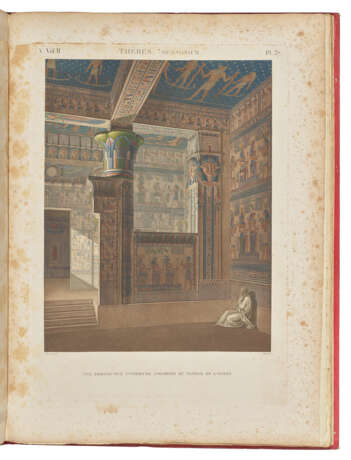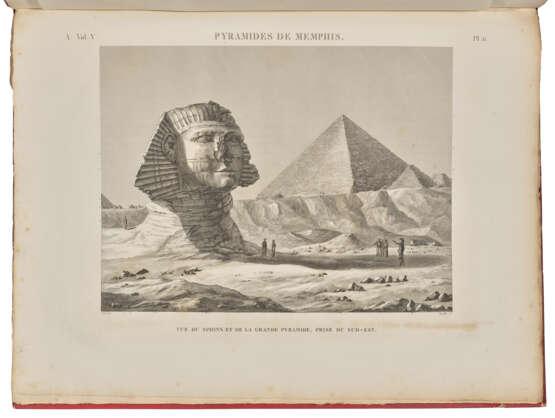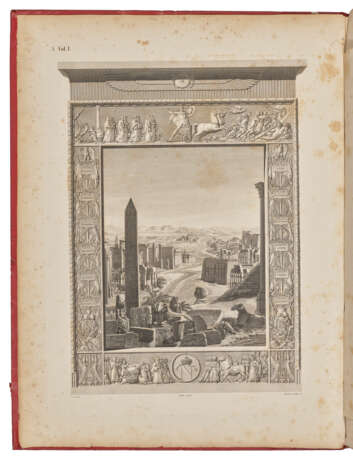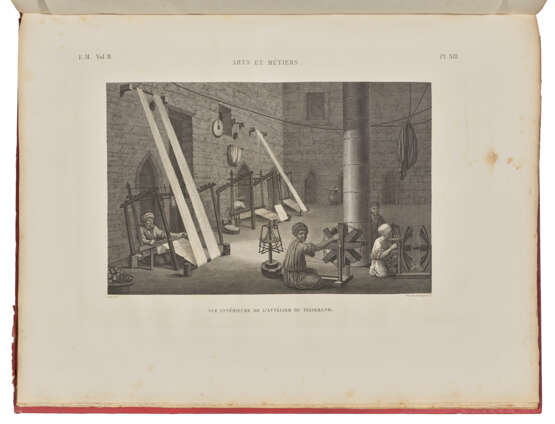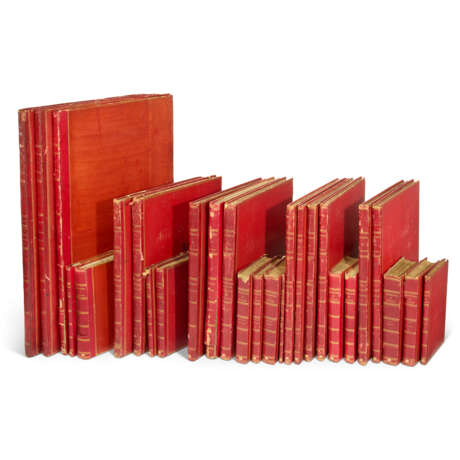ID 1450521
Lot 111 | Description de l'Egypte
Estimate value
£ 100 000 – 150 000
Description de l'Egypte, ou Recueil des observations et des recherches qui ont été faites en Egypte pendant l'expédition de l'Armée française. Paris: Imprimerie Impériale, 1809-1812, Imprimerie Royale, 1817-[1830]
First edition of the magnificent Napoleonic report on ancient and modern Egypt, the beginning of modern Egyptology, and the most significant publication ever produced by the French government. A truly monumental work, comprising 18 volumes bound in 27, including three grand monde folios of plates. The contents are arranged into three categories: Antiquités, L'État moderne, and Histoire Naturelle, with text and plates bound separately. Publication took place over several decades, with livraisons released not necessarily in the order in which they are bound; copies with differing plate counts exist.
'Thirty years of collective effort went into the publication of this work, as well as untold suffering and privation in Egypt' (Blackmer). As early as October 1798, the mathematician Jean-Baptiste Joseph Fourier, secretary of the Institute, was entrusted with the task of uniting the reports of various disciplines with a view to publication. The huge volume of information to be published meant adopting an apparently haphazard modus operandi: when sufficient plates or text on a particular subject were ready, they were published. Started under Napoleon's regime in 1809, there was a hiatus from 1813 until 1817 when the new Bourbon king, realizing the importance of the work, placed it above politics by supporting its completion. This was finally achieved in 1830.
'The Egyptologists of the 19th-century owed their knowledge of ancient Egypt to the efforts of the engineers who described the monuments of antiquity, and it was in the plates of the Description that these were revealed' (Blackmer). It was the largest printed work so far produced, one that 'exhibits the sites of Egypt with detail augmented by each passing page, thus creating a much different viewing experience [than other contemporary view books] premised on an empirical, scientific unfolding. Beginning with an aerial map of a particular archaeological site, it then moves to a general view of the monuments in situ, followed by architectural elevation and plans, and intricate displays of any individual artifacts and inscriptions discovered' (Oliver).
Although the publication set the stage for European work on Egypt for the next two centuries, 'there has been relatively little research devoted to it, particularly involving a critical analysis of its engravings' (Oliver). Its monumentality and historical significance as a publication has overshadowed a detailed study of its contents as it actually relates to Egypt. It is in many ways a younger sibling of Diderot's great Encyclopédie, isolating areas of knowledge for practical use and consumption. It presents Egypt not as it was, but as an object for French colonial consumption, often dramatizing the sense of decay and ruin in order to emphasize the gulf between the Antiquités and L'État moderne. Edward Said writes that it was part of the effort to 'restore a region from its present barbarism to its former classical greatness; to instruct (for its own benefit) the Orient in the ways of the modern West; to subordinate or underplay military power in order to aggrandize the project of glorious knowledge acquired in the process of political domination of the Orient.'
And it worked, too. While the Napoleonic Egyptian campaign was an utter failure, with fewer than half the original troops returning home alive and the definitive loss of French influence in the region, this publication represents the French victory in Egypt. A monumentally influential work which 'gave' Egypt to the French in a more lasting way than military campaigns ever could, it is one of the most enduring remains of Napoleon's failed but legendary exploits in the arena of empire. Blackmer 476; BAL RIBA 846; Brunet II, 616-617; Nissen BBI 2234; Nissen ZBI 4608.
Together 18 volumes bound in 27, comprising:
Plate volumes: 10 volumes bound in 13, of which 10 large folio, (710 x 530mm), and 3 double-elephant folio (1090 x 694mm), all but one with half-title, 889 (of 894) engraved plates and maps, some folding or coloured, spotting to plates and titles, occasional browning
Antiquités I: half-title, engraved frontispiece, ‘Explication du Frontispiece’ (browned), ‘Noms des auteurs des dessins’, engraved map and 100 plates: 86 in this volume (one coloured), remaining 14 bound in larger volume
Antiquités II: half-title, ‘Noms des auteurs des dessins’, 92 engraved plates (18 coloured): 61 in this volume, the remaining 31 bound in larger volume
Antiquités III: half-title, ‘Noms des auteurs des dessins’, 69 engraved plates (one coloured): 43 in this volume, the remaining 26 plates bound in larger volume
Antiquités IV: half-title (browned), ‘Avertissement’, ‘Noms des auteurs des dessins’, 74 engraved plates (one coloured): 61 in this volume, the remaining 13 bound in larger volume
Antiquités V: half-title, ‘Noms des auteurs des dessins’, 89 engraved plates: 64 in this volume, 10 bound at end of Histoire naturelle volume 2 bis, 7 bound in larger volume, and 8 bound in ‘Carte Topographique’ volume
État moderne I: half-title, 4 leaves of letterpress: ‘Noms des auteurs des dessins’ (1st, 2nd and 3rd livraisons) and ‘Histoire naturelle. Noms des peintres’ (3rd livraison), folding engraved map, 81 engraved plates: 74 plates in this volume, 2 bound in larger volume, 5 bound in ‘Carte Topographique’
État moderne II: half-title, 71 engraved plates: 66 plates in this volume, 5 bound in larger volume; and 17 further plates from the État moderne bound in Histoire naturelle plate volume II bis
Histoire naturelle I: half-title, 73 engraved plates
Histoire naturelle II: half-title, 85 engraved plates, (without contents leaf)
Histoire naturelle II bis: without half-title, 5 leaves of letterpress text (‘Noms des auteurs des dessins. État moderne, tome premier’, ‘Noms des auteurs des dessins. État moderne, tome second’, ‘Histoire naturelle. Noms des peintres […] Zoologie’, ‘Noms des auteurs qui ont fourni les dessins. Histoire naturelle, I.er et II.e volumes. Zoologie’, and ‘Environs d’Alexandrie, Taposiris. Explication des planches’), 86 engraved plates of Histoire naturelle (some coloured); together with 17 plates from the État moderne, and 10 plates from the Antiquités (as noted above)
3 grand monde folio plate volumes (1090 x 694mm), comprising:
Carte topographique: engraved title, key plate and 47 engraved maps (3 with two sections per plate), (without letterpress "Noms des ingenieurs"), together with 13 plates from Antiquités and État moderne as mentioned above, and:
2 volumes containing larger plates from the above works (as noted above)
3 grand monde folio plate volumes (1090 x 694mm), comprising:
Carte topographique: engraved title, key plate and 47 engraved maps (3 with two sections per plate), (without letterpress "Noms des ingenieurs"), together with 13 plates from Antiquités and État moderne as mentioned above, and:
2 volumes containing larger plates from the above works (as noted above)
Text volumes: 8 volumes bound in 14, one volume large folio (710 x 530mm), and 13 volumes folio (402 x 250mm) comprising:
Préface historique: large folio, half-title, ‘Préface historique’ (92pp.), ‘Avertissement’ (8pp,) and ‘Explication des planches’ (for Antiquités volumes I-V), some spotting
Antiquités descriptions: 3 volumes, folio, volume 2 with 3 engraved portraits (Gaspard Monge, Michel-Ange Lancret, and Claude-Louis Berthollet), 16 plates of the Rosetta Stone, one plate of medals, and 2 folding maps of Egypt
Antiquités mémoires: 2 volumes, folio, volume 1: folding engraved map, 2 plates (one folding), 10 sheets of tables (some folding), volume 2: 2 plates
Etat moderne: 2 volumes bound in 4 (volume 2 bound in 3), folio, volume 1 includes typeset music, volume 2: one engraved plate of coins, 2 folding plates, includes description of plates I-XXX of the Arts et Métiers at end
Histoire naturelle: 2 volumes bound in 4, folio
All volumes bound in contemporary near-uniform red morocco-backed red paper boards (some plate volumes with Tessier’s binder’s label), flat spines gilt, text and plates uncut (spotting, occasional browning and marginal dampstaining, bindings worn, some covers of text volumes detached, some tears and loss to spines). Provenance: Charles Evan Fowler, bookplates—French Institute Alliance Française, New York City, Gift of Mr Albert Morris Bagby (1932), bookplates, inkstamps—sale at Christie’s New York, 11 November 1994, lot 31—library shelf-mark labels to spines, occasional library ink stamps.
Due to the variance in collations of copies, sold not subject to return.
| Auction house category: | Books and manuscripts, Printed books |
|---|
| Auction house category: | Books and manuscripts, Printed books |
|---|
| Address of auction |
CHRISTIE'S 8 King Street, St. James's SW1Y 6QT London United Kingdom | |
|---|---|---|
| Preview |
| |
| Phone | +44 (0)20 7839 9060 | |
| Buyer Premium | see on Website | |
| Conditions of purchase | Conditions of purchase |

